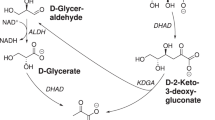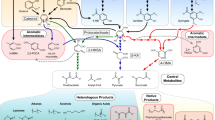Abstract
Phenylalanine was produced from phenylpyruvate at up to 30 g/l in molar yields as high as 98% using polyazetidine immobilized E. coli high in aspartate phenylalanine transaminase. E. coli mutants containing only the tyrosine phenylalanine transaminase (tyrB) or the branched chain transaminase (ilvE) were unable to convert phenylpyruvate to phenylalanine at high levels. Aspartic acid was the amine donor of choice as the oxaloacetic acid produced in the reaction was readily decarboxylated to pyruvic acid under the experimental conditions thereby driving the reaction to completion. The catalyst had a projected half–life of greater than 8 months at temperatures of 37–41°C.
This is a preview of subscription content, access via your institution
Access options
Subscribe to this journal
Receive 12 print issues and online access
$209.00 per year
only $17.42 per issue
Buy this article
- Purchase on Springer Link
- Instant access to full article PDF
Prices may be subject to local taxes which are calculated during checkout
Similar content being viewed by others
References
Tsuchida, T., Matsui, H., Enei, H., and Yoshinaga, F. 1975. L-Phenylalanine by fermentation. U.S. Patent 3,909,353.
Choi, Y.J. and Tribe, D.E. 1982. Continuous production of phenylalanine using an Escherichia coli regulatory mutant. Biotechnol. Lett. 4:223–228.
Yamata, S., Nabe, K., Izuo, N., Nakamichi, K., and Chibata, I. 1981. Production of L-phenylalanine from trans-cinnamic acid with Rhodotorula glutinis containing L-phenylalanine ammonia lyase activity. Appl. Environ. Microbiol. 42:773–778.
Nakamichi, K., Nabe, K., Yamada, S., Tosa, T., and Chibata, I. 1984. L-phenylalanine formation from acetamidocinnamic acid by newly isolated bacteria. Appl. Microbiol. Biotechnol. 19:100–105.
Sakurai, S. 1956. Enzymatic preparation of optically active essential amino acids. I. The preparation of L-phenylalanine. J. Biochem. 43:851–855.
Asai, T., Aida, K., and Oishi, K. 1960. Preparation of L-phenylalanine by bacterial transaminase. Hakko To Taisha 2:114–119.
Kitai, A., Kitamura, I., and Miyachi, N. 1962. The formation of L-amino acids through the conjugated reaction system. I. The formation of L-alanine and L-phenylalanine by the alcohol dehydrogenase conjugated system. Hakko To Taisha 5:61–65.
Wandrey, C., Wichmann, R., Leuchtenberger, W., Kula, M.-R., and Buckmann, A. 1982. Process for the continuous enzymatic change of water soluble ketocarboxylic acids into the corresponding amino acids. U. S. Patent 4,304,858.
Ziehr, H., Hummel, W., Reichenbach, H., and Kula, M.-R. 1984. Two enzymatic routes for the production of L-phenylalanine. 3rd European Congress on Biotechnology, Verlag Chemie, Weinheim. 1:345–350.
Bulot, E. and Cooney, C.L. 1985. Selective production of phenylalanine from phenylpyruvate using growing cells of Corynebacterium glutamicum. Biotechnol. Lett. 7:93–98.
Fusee, M.C. 1985. Amino acid production from alpha-keto acid by microbiological conversion. German patent application DE3427495 A1.
Gelfand, D.H. and Steinberg, R.A. 1977. Escherichia coli mutant deficient in the aspartate and aromatic amino acid amino transferases. J. Bacteriol. 130:429–440.
Calton, G.J. and Wood, L.L. 1984. A novel method of immobilization and its use in aspartic acid production. Bio/Technology 2:1081–1084.
Fusee, M.C., Calton, G.J., and Swann, W.E. 1981. Immobilization of Escherichia coli cells containing aspartase activity with polyurethane and its application for L-aspartic acid production. Appl. Environ. Microbiol. 42:672–676.
Sato, T., Nishida, Y., Tosa, T., and Chibata, I. 1979. Immobilization of Escherichia coli cells containing aspartase activity with K-carrageenan. Biochim. Biophys. Acta. 570:179–186.
Author information
Authors and Affiliations
Rights and permissions
About this article
Cite this article
Calton, G., Wood, L., Updike, M. et al. The Production of L–Phenylalanine by Polyazetidine Immobilized Microbes. Nat Biotechnol 4, 317–320 (1986). https://doi.org/10.1038/nbt0486-317
Received:
Accepted:
Issue Date:
DOI: https://doi.org/10.1038/nbt0486-317



